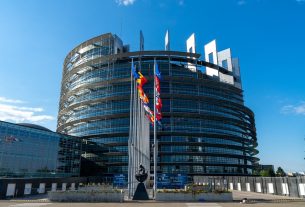Ethan E. Butler, Peter B. Reich, Neha Mohanbabu, and Forest Isbell from the University of Minnesota, USA, Zhong Wang from the Wuhan University inChina, and Xiujuan Qiao from the Wuhan Botanical Garden, Chinese Academy of Sciences, discuss their article: Elevated CO2 and enriched nitrogen proportionally decrease species richness most at small spatial scales in a grassland experiment
Global changes negatively impact biodiversity, but do they act similarly at different spatial scales? If not, are there certain scales that are more prone to biodiversity loss than the other scales? These questions have rarely been asked in the context of global change studies, probably because of the enormous amount of work needed for such highly spatially resolved data in grasslands. In the summer of 2019, Zhong Wang surveyed a subset of plots in BioCON (Biodiversity × CO2 × Nitrogen experiment) in Cedar Creek, MN, USA, by laying a lattice over every 4 m2 plot and recording species presence and cover in each 10 x 10 cm cell. This technique allowed us to evaluate diversity across three orders of magnitude (four, with some additional mathematical analysis), which we considered to be extremely novel relative to the overwhelming majority of diversity studies that only consider a single spatial scale. Furthermore, he evaluated this range of spatial scales across four treatments: a control, increased nitrogen (N), increased CO2, and both increased N and CO2, with every species and its cover exhaustively surveyed at the peak of summer. The effort to collect these observations was enormous, and Prof. Wang’s persistence and effort was the groundbreaking effort that made the rest of the analysis possible. When he presented the data to the Forest Ecology Research Seminar at the University of Minnesota’s Department of Forest Resources, we (Ethan Butler and Peter Reich) suspected there was an opportunity to push for a more general result connecting the treatments to a range of spatial scales.

Our initial goal was to see if the changes in species richness that had been observed over numerous studies at modest spatial scales within the experiment could be generalized for broad application by applying the classic species-area relationship (SAR). The loftiest hope was that we might find a relationship robust enough in the “microcosm” of a grassland experiment that it could be extended to other larger systems, such as forests. However, we had an unexpected result after the first application of SAR to these data. While suppression of species richness by the treatments held at the scale of local interactions, the proportional treatment effects – particularly for nitrogen – appeared quite blunted at the largest spatial scales. The treatment effects were different at different scales!
When we evaluated other metrics of diversity, which progressively weighed the influence of common species more heavily, the effect of the treatments was much more uniform across space. The treatments suppressed average community diversity across all spatial scales, but the treatments had less of an effect on the appearance of rare species, which was most apparent at the largest spatial scales. It appears likely that the mesocosm of the experiment was influencing the appearance of rare species at the full plot scale. This makes sense given the construction of BioCON – the CO2 treatment is uniform within a ring, but the N treatment varies within the CO2 rings, so an ambient N plot may be right next to (within 10’s of centimeters) an elevated N plot. Other work at Cedar Creek showed that many of the species that live within BioCON have wind-driven dispersal ranges of approximately 1 m, so there is ample room for species that are rare in the most diverse plots to re-colonize a limited area when a gap is opened, either via wind driven dispersal or from within the existing seedbed. This homogenization at larger spatial scales was reinforced by an analysis that aggregated all species counted within each treatment together and found that treatments actually had a larger richness than the control.

The unexpected blunting of increased N and CO2 needs to be understood in the context of the experiment, and so – unfortunately – we didn’t find as general an outcome as we had initially hoped. However, we find it encouraging that our results suggest that while these environmental perturbations do decrease species richness (both independently and additively), there is some hope that if rare species can survive in refugia, they may be able to re-colonize their old habitats, even under altered conditions.

